
An aerial view of the Long Biên Bridge in 1985
This article was published previously in Saigoneer http://saigoneer.com
Described by one writer as “a misshapen but essential component of Hà Nội’s heritage,” the Long Biên Bridge has clearly seen better days, but still commands such affection that recent government proposals to relocate or rebuild it have now been abandoned. What better time to revisit the long and turbulent history of this Hà Nội icon.
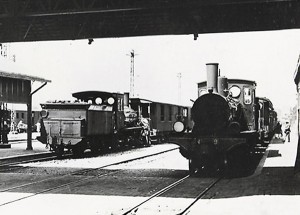
Steam locomotives at Hà Nội Station in the early 1900s
The Long Biên Bridge was conceived primarily as part of the government-run (Chemins de fer de l’Indochine, CFI) railway line from Hà Nội to Đồng Đăng (built 1899-1902), but from the outset it was also intended as a means of connecting the capital with a second railway line then under construction. The line from Hải Phòng to Lào Cai and Yunnan (built 1901-1910), operated as a franchise by the Compagnie française des Chemins de fer de l’Indochine et du Yunnan (CIY), did not enter the capital, so a connecting service had to be provided across the river from Hà Nội to Gia Lâm. Because of its dual function, the bridge became part of a “communal” railway line administered jointly by both CFI and CIY.
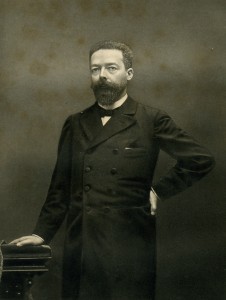
Paul Doumer, Governor General of Indochina from 13 February 1897 to October 1902
The bridge was originally named after Paul Doumer, the French Governor General who championed the cause of railway construction and whose ambitious “1898 Programme” laid the groundwork for the construction of over 1,300km of railway line in Việt Nam between 1898 and 1914, followed by over 1,100km more during the period 1918–1936.
Costing just over 6 million Francs, it was built between 1899 and 1902 to an in-house design by Daydé et Pillé, following a competition which involved all of the major construction houses. The bridge was inaugurated on 2 February 1902 in the presence of Doumer himself, his successor Paul Beau and the young King Thành Thái, and the first train crossed the bridge on 28 February 1902.
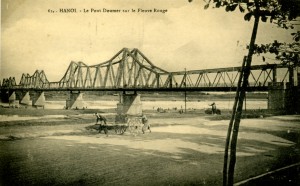
The Doumer Bridge soon after completion
The bridge’s complex 19-span, 20-column cantilever design was immediately fêted as a technological masterpiece. Arriving in Hà Nội soon after it opened, awestruck British travel writer Alfred Cunningham noted:
“It is one of the longest bridges in the world, its total length being 1,680 metres (5,505 feet). According to Doumer’s memoirs, the engineers who constructed it were Messrs Daydé et Pillé, Creil (Oise) and the superintendent engineer in charge of its erection informed us that his task had been very difficult owing to the subsidence of the soil and the bed of the river. The earthwork leading up to the bridge had sunk three times, to a total depth of three metres, but he thought that was final. The stone columns, 14 metres high, are built up on metal cylindrical piles, 30 metres deep, which are filled with cement. There are 20 stone columns and some idea of its dimensions may be gathered from the fact that it absorbed 80 tons of paint, and the total weight of the steel is 5,000 tons. It is a magnificent work of which the French colonial government may well be proud, as a feat of modern engineering skill, and as a colossal monument to their desire to improve the communications between the provinces and the capital.”
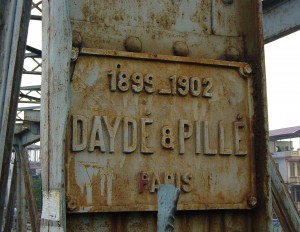
The original builders’ plate of the Doumer Bridge (photo: Tim Doling)
In fact, at the outset this massive structure carried just a single-track railway line bordered by pedestrian walkways, obliging those wishing to cross the Red River by motor vehicle or rickshaw to take a ferry. This has prompted some historians to suggest that the bridge, like many other French colonial structures, was conceived more for its symbolic value than as a key transport hub.
Ironically, the bridge is remembered today not as a symbol of colonial power and prestige, but rather as an icon of defiance against the Americans during the second Indochina War.
The bridge’s links with revolutionary history began in the period immediately after the First Indochina War, when the French used the Hà Nội-Hải Phòng line to evacuate their civilians and troops. It was across the Doumer Bridge that the final contingent of French soldiers walked on the afternoon of 9 October 1954, after withdrawing from the Hà Nội Citadel. The Việt Minh then took possession of the bridge, officially renaming it Cầu Long Biên. On the morning of 10 October 1954, Việt Minh troops entered the city, declaring the capital liberated.

US bomb damage in August 1967
Its strategic function later made the bridge a key target for US bombers. In March 1965, as the Americans unleashed their sustained aerial bombardment known as “Operation Rolling Thunder,” anti-aircraft guns were installed on the central bridge towers. However, in 1966-1967 the bridge was hit on no fewer than 10 occasions. At first, running repairs succeeded in keeping it open to rail traffic, but in August 1967 the central span was destroyed, severing the vital rail link across the Red River.
During the ensuing eight-month reconstruction period, an extraordinary floating bridge known as SH1 (Sông Hồng 1) was installed to maintain rail transport between Hà Nội and Gia Lâm – barges were used to move the pontoons into place at night and then float them away again before first light.
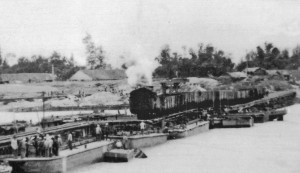
Temporary pontoon bridge “SH2”
Nixon’s “Operation Linebacker” of May–October 1972 inflicted further damage on the Long Biên Bridge by hitting it on four occasions, demolishing three more spans and once more severing the vital rail link between the capital and the north. As before, a pontoon bridge system – this time known as SH2 – was hastily installed across the Red River to reconnect Hà Nội with Gia Lâm.
Altogether, seven spans and four support columns were destroyed during the American War. After the Paris Peace Accords, work began to rebuild the bridge using steel supplied by the USSR, and by March 1973 trains were once more running through from Hà Nội to Gia Lâm junction. Since the need to ensure architectural integrity was not high on the agenda, those wartime reconstructions left only half of the bridge with its original shape.
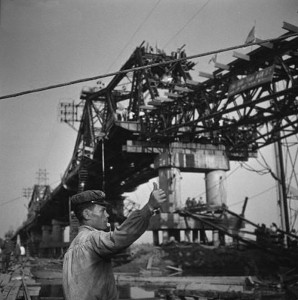
Rebuilding the Long Biên Bridge in 1973
The current debate over the bridge’s future stems from proposals elaborated nearly a decade ago to establish a fully integrated public transport system in Hà Nội, incorporating outer and central suburban railway lines run by ĐSVN, citywide bus services and a five-line Metro network. This ambitious scheme demands the provision of a multi-track railway bridge to carry the main line, Metro Line 1 and the proposed central suburban line across the Red River.
Now that the scheme to relocate or rebuild the Long Biên Bridge has been abandoned, it is likely that a new railway bridge will be built further upstream, as originally proposed. Meanwhile, the Ministry of Transport has reportedly agreed to keep the structure of the Long Biên Bridge intact, renovating parts of it “to improve its transport capability.”
Back in 2007, the French government pledged financial support to “restore the bridge to its original appearance.” But perhaps the last word should go to William Logan who, in his 2000 book Hanoi: Biography of a City, argues that while the Long Biên Bridge was a remarkable French engineering and architectural achievement, it is the bridge’s misshapen, unrestored spans which make it such a special symbol of the indomitable Hà Nội wartime spirit.
Tim Doling is the author of The Railways and Tramways of Việt Nam (White Lotus Press, Bangkok, 2012) and also gives talks on Việt Nam railway history to visiting groups.
A full index of all Tim’s blog articles since November 2013 is now available here.
Join the Facebook group Rail Thing – Railways and Tramways of Việt Nam for more information about Việt Nam’s railway and tramway history and all the latest news from Vietnam Railways.
You may also be interested in these articles on the railways and tramways of Việt Nam, Cambodia and Laos:
A Relic of the Steam Railway Age in Da Nang
By Tram to Hoi An
Date with the Wrecking Ball – Vietnam Railways Building
Derailing Saigon’s 1966 Monorail Dream
Dong Nai Forestry Tramway
Full Steam Ahead on Cambodia’s Toll Royal Railway
Goodbye to Steam at Thai Nguyen Steel Works
Ha Noi Tramway Network
How Vietnam’s Railways Looked in 1927
Indochina Railways in 1928
“It Seems that One Network is being Stripped to Re-equip Another” – The Controversial CFI Locomotive Exchange of 1935-1936
Phu Ninh Giang-Cam Giang Tramway
Saigon Tramway Network
Saigon’s Rubber Line
The Changing Faces of Sai Gon Railway Station, 1885-1983
The Langbian Cog Railway
The Lost Railway Works of Truong Thi
The Mysterious Khon Island Portage Railway
The Railway which Became an Aerial Tramway
The Saigon-My Tho Railway Line

